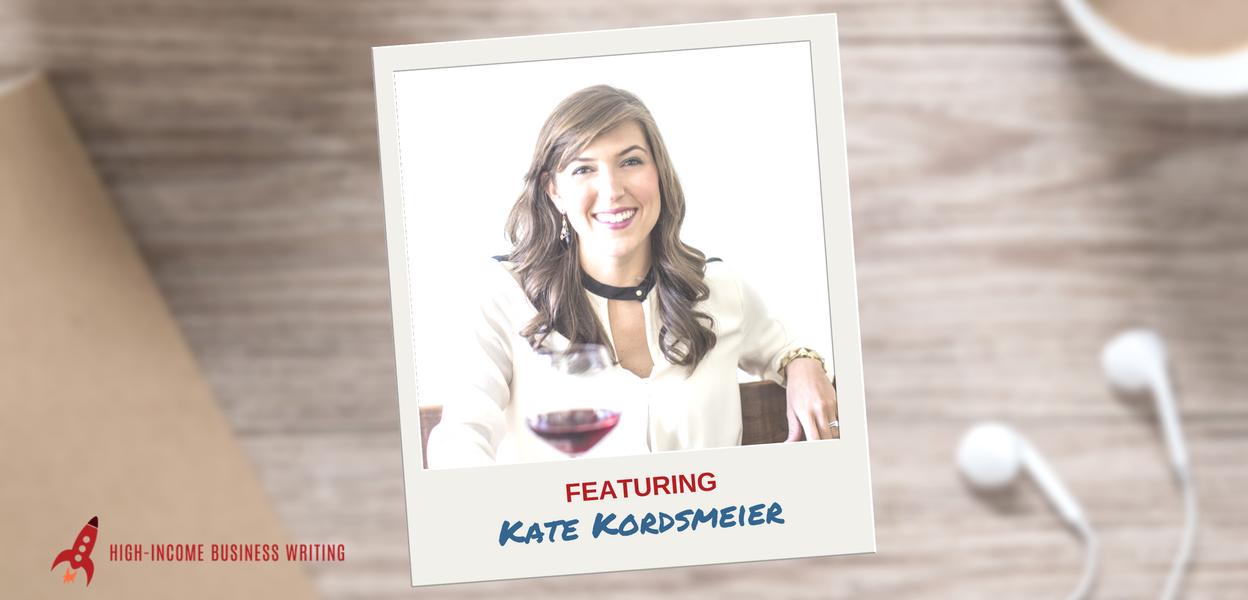I always assumed that food and travel writing didn’t pay well.
It just seemed crowded with writers. And as media companies started to fold, this category felt like a starving artist’s (no pun intended) worst nightmare.
But I recently met someone who challenged these assumptions. Her name is Kate Kordsmeier and she’s my guest in this week’s show.
In this interview Kate will explain why there’s still a very good income opportunity in food and travel writing.
She’ll tell you how she got her start, how she climbed her way up, where the best opportunities are, what the pay is like, and what to do if you want to earn a good living and enjoy your work.
The notes that follow are a very basic, unedited summary of the show. There’s a lot more detail in the audio version. You can listen to the show using the audio player below. Or you can subscribe in iTunes to get this show delivered straight to the Podcasts app on your smart phone, tablet or iPod.


High-Income Business Writing with Ed Gandia
#105: Kate Kordsmeier on the High-Income Opportunity in Food & Travel Writing
Tell us about yourself
Kate Kordsmeier has been working as a fulltime freelance writer since 2010. She writes about food and travel for magazines, newspapers and websites. She has also hosted travel shows and authored a couple books.
Most of her writing is editorial journalism, covering news, profiles, trends and recipes in the food and travel space.
In addition to consumer magazines, she also writes for some trade and custom publisher magazines (such as in-flight magazines).
How did you get into this line of work?
Kate intentionally set out to become a full time freelance food and travel writer. She started by going to journalism school and interning with a freelance writer and several magazines.
When she finished school, she took a job as a full time copywriter for about six months. Then, about seven years ago, she left to pursue a full time freelance career.
What kind of writer is best suited for this kind of work?
You have to be self-motivated, self-disciplined and driven. You have to have a thick skin. Rejection and non-response is part of the job. If your pitches aren’t accepted, you can’t take it personally.
You have to be willing to sell yourself and your ideas. Kate is constantly always pitching her skills and services.
Are the perks of freelancing in the food and travel space real?
Yes. Kate gets a lot of free meals and trips. She’s been able to do lots of things she couldn’t afford on her own.
But at the same time, you can’t pay your mortgage with a free meal or vacation. Your waistline and health may also pay a price for eating out and traveling so much.
Kate will only travel is she can get some writing out of it. Usually, she tries to get at least three stories out of each trip.
And no trip is ever 100 percent free. You still have to tip servers and guides.
How much of your work comes to you versus you pitching article ideas?
When she first started, 100 percent of her work came from pitches. But as people got to know her, they started coming to her. Today, the split is about 50-50, although it varies.
She spends as much time running her business, promoting her services, pitching editors and researching story ideas as she does writing.
What’s involved in pitching?
Consumer magazines: You send a story idea to an editor. You briefly describe yourself and your story idea and then wait for a response.
Trade or custom publishers: You send a letter of introduction. They look at their story ideas (which they develop in house) and see if you’re a good match to write any of them.
What’s your approximate success rate with pitching?
At one point, it was about five percent. Kate’s success rate improved as she got more experience and developed relationships.
But magazine editors move around a lot. So even if you have an editor who loves your stuff, he/she may get replaced with someone who doesn’t. You can never get too comfortable.
How well do these projects pay?
Over the last five years, Kate’s average project rate was about $1000. Her average internal hourly rate was about $155.
She’s usually working on six to 12 projects at a time.
You can reach a six-figure income writing in the food + travel space, if you do it well.
How do you keep your internal hourly rate high?
You have to be strategic about whom you write for and how you spend your time. Kate tracks everything, including how long projects take, how well clients pay and the nature of the working relationships. She then creates client report cards. She uses these to figure out which clients to pursue and which to drop.
Sometimes it’s better to say no to a client and use that time to find a better paying client or a better paying market.
Are there opportunities to branch out from client writing into other areas?
Yes. Kate has written a couple books. People approached her to write them because she had established herself as an Atlanta food writer.
Recently, she started a food and wellness blog called Root and Revel. She wanted to have more control over her content and not be beholden to editors and advertisers. The blog also allows her to write more first person stuff.
Are there good opportunities in this field for someone who’s never worked in it?
There’s no prerequisite to work in this area, especially if you can leverage your previous experiences.
In her entire freelance career, no client has ever asked her if she went to journalism school.
To break into food/travel writing, come up with story ideas you’re uniquely qualified to write.
Another approach is to intern with a freelancer or magazine to learn the business.
Above all, you have to study magazines and market yourself like crazy.
What are the biggest lessons you’ve learned from working in this field?
- You can make good money as a writer in this space.
- You don’t have to be the most talented writer to be the most successful writer. It’s just as important to be reliable, meet deadlines, answer emails and be easy to work with.
Where can listeners learn more about you?
Kate’s website: Kate Parham Kordsmeier
Kate’s blog: Root + Revel
Twitter: @KPKords






